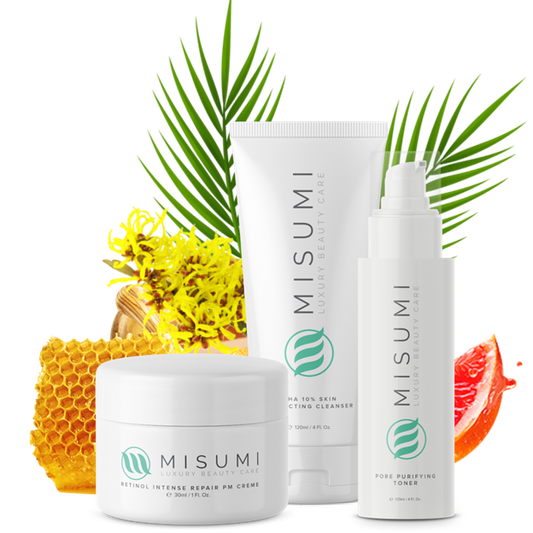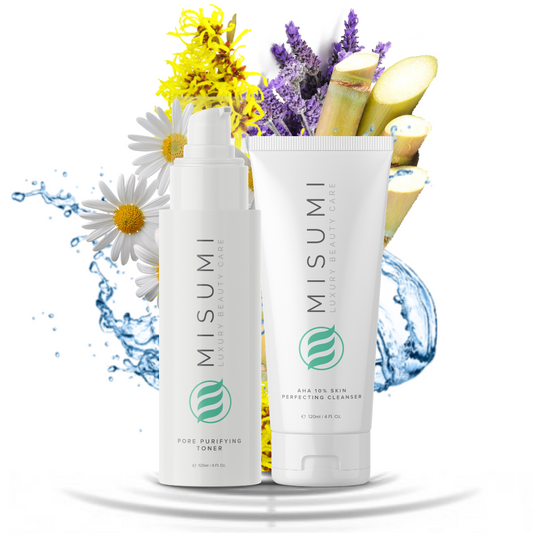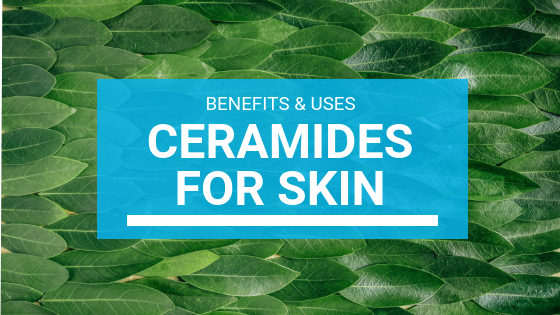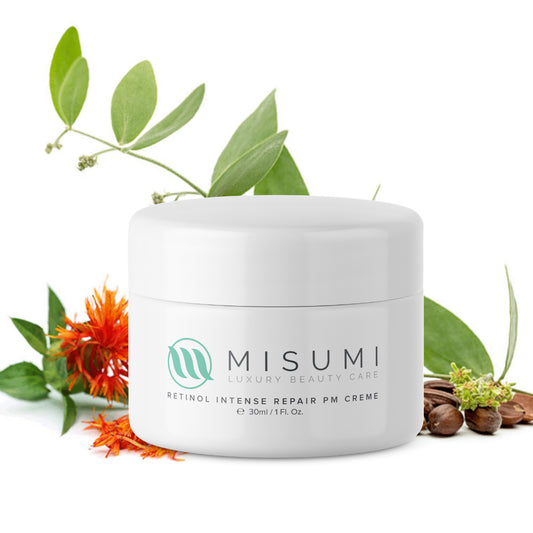Have you heard of ceramides? You probably haven’t, which is not surprising. Ceramides are probably some of the most consistently used, but at the same time, most unappreciated and often overlooked skincare ingredients. While ceramides won’t really make you get rid of acne, they are, nonetheless, one of the most effective ingredients used to combat signs of aging. Read on and learn all about how ceramides protect the skin barrier, moisturize our skin, and keep us looking fresh and young.
What Are Ceramides?
Let’s get technical for a moment here. Ceramides are a class of lipid molecules that are commonly found within the cell membranes in the epidermis - the surface layer of the skin. The surface layer of our skin is simply overflowing with these lipids (fatty molecules), called ceramides. Some estimates claim that at least 40% to 50% of our uppermost skin layer is actually made up of ceramides.

This means that ceramides act as a sort of building blocks for our skin’s surface. They hold our skin cells glued together, creating an impermeable layer protecting our skin from the elements and retaining moisture at the same time. This protective layer plays a very significant role in not just our skin’s health, but our overall health, and it’s called the skin barrier. Think of ceramides like the natural roof tiles, or microscopic scales that cover our skin. They are small, they are many, they cover our skin and play a significant role in its protection.
What Do Ceramides Do?
Scientists were initially interested in ceramides due to their many, and significant roles in the development of our brain and nervous system. However, gradually, they were recognized for their powerful roles in maintaining our skin’s health too. So what do ceramides do for the skin?
Ceramides make around 50% of the material in the skin barrier, providing a sort of thin roof, spread over the uppermost skin layer. The rest is made up of 25% cholesterol, 15% free fatty acids, and some keratin.
Covering our body like this, ceramides prevent bacteria, environmental pollutants, and dust from entering our bodies. Like roof tiles, ceramides keep anything bad from entering in, but they also make sure everything good is closed inside. By reinforcing our skin barrier, ceramides decrease our skin’s permeability, keeping precious water molecules inside. Locking moisture into our skin like this, ceramides help our skin from becoming dry and irritated.

Additionally, this also protects our skin from environmental pollutants and other kinds of damage, like the Sun’s UV radiation. By strengthening our skin barrier, ceramides can also delay aging, and protect our skin from the Sun by making it less photosensitive. Wrinkles and fine lines are more pronounced if your skin is dry, and bu making it hydrated, ceramides reduce the appearance of wrinkles too.
So, needless to say at this point, but as you can imagine, ceramides play a very significant role in our skin’s health, and in turn, in skincare.
If I Already Have Ceramides, Why Do I Need Ceramide From Skincare Products?
That’s a very good question. It also applies, however, to a number of other ingredients used in skincare, such as hyaluronic acid, L-Lysine and so on. The (sort of sad) truth is that even though our bodies produce a lot of what’s needed for us to be healthy, it gradually loses that capability as we age. After we hit 30, our skin begins a slow decline of its maintenance functions. This makes it slower to produce collagen, elastin, and of course - ceramides.
As you can imagine, this is part of why we age, and why our skin becomes drier, more rugged and more wrinkled as time goes by. This means that regardless of how healthy you feed yourself, the body just isn’t operating at 100% efficiency. That is because the cells themselves experience damage due to all the oxidative stress from the free radicals. Those free radicals can be fended off with a hefty dose of antioxidants, but that's another topic for another day.

All of this means that your skin becomes dry, aged, and damaged regardless of you having ceramides in your skin. It also means that it’s good to supplement those lost ceramides through skincare products. So, that is why you kinda need ceramides from skincare products, even though you already have them in your skin.
Use Of Ceramides In Skincare
So, your next question might be which ceramides does skincare make us of, and for what purposes specifically. And we’re here to answer it for you.
For the most part, skincare products employ ceramides for the purpose of replenishing the naturally lost lipids on the surface layer of the skin. This achieves several goals, such as reinforcing your skin barrier, making your skin more resilient to the elements, and increase the skin’s ability to moisturize itself. The products themselves don’t have to do a lot of work - their job is to deliver a hefty amount of ceramides on your skin. From that point onward, it is the ceramides that have to do their magic which results in improving your skin immensely.
Additionally, you will find skincare products, and even ceramides-based prescribed medications in the form of gels, creams, ointments and so on, for treating eczema. Eczema is a particularly stubborn and annoying atopic dermatitis affecting mostly the surface layers of the skin. Which, in a way, makes ceramides especially suited for its treatment.

And not only that - products and medications that contain ceramides are also particularly effective for people who have certain kinds of psoriasis. Since psoriasis also entails the loss of ceramides and persistent damage to the surface layer of the skin, ceramides can be especially effective in alleviating its symptoms.
Finally, people with mature or aging skin, sensitive skin, or dry, damaged or irritated skin can find skincare products that contain ceramides very soothing. The ceramides in these products can sort of fill the gaps in the surface layer of your skin, repairing your skin barrier. This will boost your skin’s resilience against the elements and make it more efficient at retaining its moisture. Besides protecting you from irritation, the ceramides will also make your skin look plumper, smoother, clearer, and more youthful.
Are Ceramides Safe To Use?
At this point, you’re probably wondering what the side effects of ceramides are. Seeing as they are already produced by your body and make at least half of your skin, you shouldn’t worry.
However, it needs to be pointed out that the only natural ceramides in existence are those found in your skin. Okay, in other people’s skin too, but good luck trying to use those. Most of the ceramides found in skincare products are synthetically produced. However, just because something is made in a lab doesn’t make it that much different from the real thing found in nature. The chemical formula and molecular structure are pretty much the same, and the body has no problem using it.

But, if you have any concerns or reservations whether your skin will be friends with a product containing ceramides, don’t worry. There is a solution for that too, and it comes in the shape of performing a patch test. Patch tests are super simple to do - all you need to do is apply a small amount of the ingredient or the product on your skin (for example, over an area as large as a penny). Ideally, you should cover the spot where you applied the ingredient or product with a bandaid or bandages; alternatively, clean cloth will do. Then… You do nothing and just wait for 24 hours.
If you experience no side effects, your skin is okay with the new product or ingredient and you can continue using it. However, if you experience any adverse reactions, like itching, soreness, redness, irritation, flaking, burning and so on, you should wash your skin immediately and forget about using the product.
So far, there have been no documented cases of allergic reactions to ceramides, but you never know. Most skincare products aren’t comprised of just one thing, but dozens, if not hundreds, and who knows what might trigger your skin into a reaction. Remember, you can do a patch test for any kind of ingredient or product. It will save you a lot of trouble, and in extreme cases, even a trip to the hospital. Better be safe than sorry as the saying goes.

What Are The Natural Sources Of Ceramides?
But let’s say you don’t plan on slathering ceramides-containing skincare products to the rest of your life, in order to keep your skin looking young and healthy. So, you’re interested in the “more natural” ways to help your body produce more ceramides. There are several ways in which you can do this, and it mainly boils down to including healthy fats to your food regimen. Eating the following foods more frequently can help your body gain more precious ceramides:
- Wheat
- Rice
- Soy
- Sweet potatoes
- Corn
What's Better: Ceramides From Foods And Supplements, Or Ceramides From Skincare Products?
It’s a clear question, but sadly, there is no clear, one-size-fits-all answer to it. Both types and sources of ceramides are good, but depending on your specific health issues, or your desires, you may need some more than others.
People with skin conditions may benefit greatly from taking ceramide supplements, and the same goes for introducing the aforementioned foods to their diet. Having a skin condition means that the body may not be able to produce enough ceramides to protect itself. That is why supplying it extra ceramides through food or supplements is generally a good idea. It’s basically helping your body from the inside, instead of only externally. Of course, it goes without saying that these people will also benefit from using ceramide-rich skincare products topically.

On the other hand, skincare products that contain ceramides may be better suited for people who don’t have chronic skin conditions and are mainly looking to improve the appearance or quality of their skin. Depending on which of these categories you fall into, you can either take ceramides supplements and modify your diet, or, you can just stick to using ceramides topically thanks to skincare products. Ceramides are great if you’re looking to moisturize your skin, or reduce signs of aging.
Can I Combine Ceramides With Something Else?
You’re also wondering if you can use ceramides in combination with other ingredients, substances, or skincare products. This question doesn’t only arise in regards to ceramides, but for almost any ingredient used in skincare as well. If you can, it’s all great. But if you cannot, who knows - you might burn yourself or cause yourself some undue unpleasantness or irritation.
To cut to the chase, the answer is yes. You can use ceramides in combination with other substances used in skincare, and to good effects. Usually, when ceramides are used in tandem with other ingredients, they have an enhancing effect on their properties. If you combine ceramides with the following substances, you will see better results than if you used them separately:
- Retinol
- Antioxidants
- Peptides
Combining ceramides with antioxidants, peptides, retinol or other retinoids (such as Retin-A), will not cause any adverse reactions and will boost their effectiveness.

Types Of Ceramides Products
Ceramides are widely used in cosmetic, beauty, and skincare products, in various formulas for various purposes. Depending on your skin type, you will need a specific type of ceramide product.
Moisturizing Creams
For example, if you have a mature, aging, or dry skin, you should definitely give ceramide-based creams a try. Creams and gels that contain ceramides are also richer in water and moisture, allowing your skin to be more thoroughly moisturized.
Additionally, skincare products that contain ceramides are also well suited as skincare routines before going to bed, for much of the same reason. The ceramides will both keep your face moisturized, and protect it during the night from any chafing or pressure.
Lotions
Body lotions that contain ceramides may also be the perfect fit for those who want to keep their entire body moisturized, especially if you live in a dry, hot climate. They are best applied right after a shower, when you’re still not completely dried up. The ceramides will sort of trap all the moisture from the shower and keep it retained to your skin.

Cleansers
Not only that, but ceramides find great use in many skin cleansers. They are usually used twice a day, and they serve to protect your skin after you’ve cleaned it.
Shampoos And Conditioners
Furthermore, ceramides are often used by shampoos, gels, conditioners and other beauty products designed to take care of your hair. In this area, ceramides work as conditioning agents, trapping moisture and precious nutrients around your hairs.
This achieves two things. First, ceramides act as a sort of wrapper around your hairs, protecting them from damage and the elements. And secondly, by trapping moisture and nutrients close to your hairs, ceramides also make sure that your scalp and hair get all the resources they need for good health. So, if you have dry, or damaged hair, you won’t make a mistake by treating it with a ceramide-rich shampoo or conditioner.
Ceramides And Sunscreen
Finally, you can be wise to apply some ceramides-rich skincare products before applying sunscreen. That way, your skin will enjoy double protection - both by a layer of natural ceramides what will boost your skin barrier, and from the sunscreen.

For Products That Contain Ceramides, The Packaging Matters
And I won’t blame you if you wonder why. But there is a very good reason why packaging is crucial when shopping for skincare products that contain ceramides.
See, the molecular structure of ceramides is such that they are very vulnerable to light and air. Once they come into contact with air and light for even a moderate amount of time, their structure breaks down. This can make ceramides, well, not ceramides anymore. Which in turn means that they lose all their amazing properties, making that tube or bottle of pricey ceramides a waste of money.
So, what to look for? When shopping for ceramides, you should avoid products that come packaged in clear bottles or loosely fastened tubes. Ideally, you’ll want your ceramide-rich product to come in an airtight, opaque tube - or a jar, a box or a bottle.
Likewise, when using ceramide products, be mindful not to leave them open for longer than necessary. The air and light that will enter the packaging can render the ceramides inert and ineffective. If you are already using a product that contains ceramides but aren’t seeing any results, contact with air and light might be the reason.

What To Look For In A Ceramide Product?
As you can imagine, there’s more than one type of ceramide product available on the market. In fact, a lot more than one. Shopping for ceramides isn’t an exception - it’s just as confusing as shopping for other skincare ingredients. So, some practical buying tips are in order.
If you are after a ceramides-rich product for the purpose of soothing irritated or dry skin, you should go for the products that contain ceramides labeled as 1, ceramides 3, or alternatively, ceramides labeled as 6-II. If you encounter ceramides labeled as 2, they’re mostly used for repairing the skin on your face and neck. Ceramides 3 can also be used for treating your face and neck.
Additionally, any product that contains ceramides labeled as NG, NP, AP, EOP, or NS, are good to go. But some products don’t contain actual ceramides, but substances that can nonetheless induce ceramides production in the body. These substances are technically referred to as “ceramide precursors,” and some of the best ones are sphingosine and phytosphingosine. Sphingosine and phytosphingosine, while not ceramides themselves, nudge our skin into making ceramides on its own, which is just as good.
So, if by any chance you can’t find a product that contains actual ceramides (which is frankly unlikely), then look for products that contain phytosphingosine and sphingosine. Think of them as ceramide seeds.

When Can I See Results From My Ceramides Treatment?
As with almost anything in skincare, results will take some time until they make themselves apparent. The effects of a moisturizer or a cleanser that contains ceramides can be almost immediately obvious. But your body will take a while until it actually incorporates all those new ceramides onto the surface layer of the skin. The same goes for any shampoos, conditioners or gels that contain ceramides. Your hair won’t just magically look better, it will take some time.
So, how long? Well, you should give ceramides at least several weeks until their labor bears fruits. Our skin undergoes a natural rejuvenation process, called desquamation, in which all cells become born, then age, then become replaced by new cells. The usual period for this to happen is around a month (or 27 days).
It’s difficult to expect any effects before your skin goes through its current cycle. Or the next one, if you’ve begun using ceramides mid-cycle. Or, even the one after that one, if your skin is particularly starved. The appearance of smoother, firmer, younger skin can become a reality from anywhere between 3 and 6 months of consistent use of ceramides.

Summing It Up
As we have seen, ceramides are completely natural, and perform several important functions for protecting our skin. From keeping our skin moisturized and its barrier strong, to helping our hair grow healthier, ceramides are almost a natural wonder. They find many uses in a wide variety of skincare and beauty products, and if used in combination with antioxidants, peptides or retinols, they can enhance their effects.
So, keep your expectations low, your spirits up, and you’ll never be disappointed. Ceramides are amazing, and if you invest in them, they will pay you back. With smooth, clear, and firm skin.
This information is meant to supplement, not replace advice from your doctor or healthcare provider and is not meant to cover all possible uses, precautions, interactions or adverse effects. This information may not fit your specific health circumstances, and its goal is to offer a general view of the subject. In case you are suffering from a severe case of acne, you should consult with a dermatologist or a certified medical professional.







